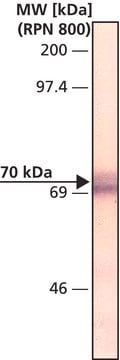추천 제품
생물학적 소스
rabbit
Quality Level
항체 형태
serum
항체 생산 유형
primary antibodies
클론
polyclonal
종 반응성
human
제조업체/상표
Upstate®
기술
inhibition assay: suitable (peptide)
western blot: suitable
동형
IgG
NCBI 수납 번호
UniProt 수납 번호
배송 상태
dry ice
타겟 번역 후 변형
unmodified
유전자 정보
human ... H2AC21(317772)
일반 설명
Histone H2AX (UniProt: P16104; also known as H2a/x, Histone H2A.X) is encoded by the H2AFX (also known as H2AX) gene (Gene ID: 3014) in human. Histones are highly conserved basic nuclear proteins that are responsible for the nucleosome structure of chromatin in eukaryotes. They play a central role in transcription regulation, DNA repair, DNA replication and chromosomal stability. DNA accessibility is regulated via a complex set of post-translational modifications of histones, also called histone code, and nucleosome remodeling. Two molecules of each of the four core histones (H2A, H2B, H3, and H4) form an octamer, around which DNA is wrapped in repeating units, called nucleosomes, which limits DNA accessibility to the cellular machineries that require DNA as a template. The histone H2A.X is a variant member of the H2A family of histones that is distinguished from other H2A histones by a unique carboxy-terminal sequence. This C-terminal tail becomes phosphorylated following double-stranded DNA breaks following irradiation or apoptosis. This unique sequence is highly conserved throughout eukaryotic evolution and is rapidly phosphorylated by ATM or ATR in response to DNA double-strand breaks. H2A.X phosphorylation is important in the formation of a stable repair complex at the site of DNA damage.
특이성
This rabbit polyclonal antibody detects Histone H2AX in human cells. It targets an epitope with in 15 amino acids from the C-terminal region.
면역원
KLH-conjugated, synthetic peptide (CSATVGPKAPSGGKKA) corresponding to amino acids 121-135 of human histone H2A.X, with an N-terminal cysteine added for conjugation purposes. The immunizing sequence has 13/15 identical amino acids in mouse.
애플리케이션
Anti-Histone H2A.X Antibody, Cat. No. 07-627, is a highly specific rabbit polyclonal antibody that targets Histone H2A.X and has been tested for use in Immunohistochemistry (Paraffin) and Western Blotting.
Immunohistochemistry (Paraffin) Analysis: A 1:1,000 dilution from a representative lot detected Histone H2A.X in human pancreas and human colon tissue sections.
Western Blotting Analysis: A 1:500 dilution from a representative lot detected Histone H2A.X in H2A and H2A.X recombinant protein.
Western Blotting Analysis: A 1:500 dilution from a representative lot detected Histone H2A.X in H2A and H2A.X recombinant protein.
품질
Evaluated by Western Blotting in Jurkat cell lysate.
Western Blotting Analysis: A 1:1,000 dilution of this antibody detected Histone H2A.X in Jurkat cell lysate.
Western Blotting Analysis: A 1:1,000 dilution of this antibody detected Histone H2A.X in Jurkat cell lysate.
표적 설명
~15 kDa; 15.15 kDa calculated.
물리적 형태
Rabbit antiserum containing 0.05% sodium azide and 30% glycerol. Liquid at -20°C.
기타 정보
Concentration: Please refer to the Certificate of Analysis for the lot-specific concentration.
법적 정보
UPSTATE is a registered trademark of Merck KGaA, Darmstadt, Germany
적합한 제품을 찾을 수 없으신가요?
당사의 제품 선택기 도구.을(를) 시도해 보세요.
Storage Class Code
12 - Non Combustible Liquids
WGK
WGK 1
Flash Point (°F)
Not applicable
Flash Point (°C)
Not applicable
시험 성적서(COA)
제품의 로트/배치 번호를 입력하여 시험 성적서(COA)을 검색하십시오. 로트 및 배치 번호는 제품 라벨에 있는 ‘로트’ 또는 ‘배치’라는 용어 뒤에서 찾을 수 있습니다.
Identification of functionally relevant histidine residues in the apoptotic nuclease CAD.
G Meiss,S R Scholz,C Korn,O Gimadutdinow,A Pingoud
Nucleic Acids Research null
Mitochondrial reactive oxygen species trigger hypoxia-inducible factor-dependent extension of the replicative life span during hypoxia.
Bell, EL; Klimova, TA; Eisenbart, J; Schumacker, PT; Chandel, NS
Molecular and cellular biology null
Telomerase inhibitor Imetelstat (GRN163L) limits the lifespan of human pancreatic cancer cells.
Burchett, KM; Yan, Y; Ouellette, MM
Testing null
H2AX chromatin structures and their response to DNA damage revealed by 4Pi microscopy.
Bewersdorf, J; Bennett, BT; Knight, KL
Proceedings of the National Academy of Sciences of the USA null
Zhijun Qiu et al.
Scientific reports, 7, 43156-43156 (2017-02-23)
Gross chromosomal rearrangements (GCRs), including translocations, inversions amplifications, and deletions, can be causal events leading to malignant transformation. GCRs are thought to be triggered by DNA double strand breaks (DSBs), which in turn can be spontaneous or induced by external
자사의 과학자팀은 생명 과학, 재료 과학, 화학 합성, 크로마토그래피, 분석 및 기타 많은 영역을 포함한 모든 과학 분야에 경험이 있습니다..
고객지원팀으로 연락바랍니다.








